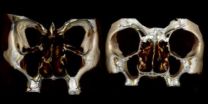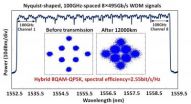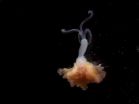(Press-News.org) Pity the poor maxillary sinuses. Those bulbous pouches on either side of the human nose are known more for trapping mucus and causing sinus infections than anything else. They were thought to be an evolutionary relic of our distant past, with little known present value.
Yet researchers led by the University of Iowa believe the unheralded maxillary sinuses play a fortuitous, integral role in the shape and function of the human nose, even today. After studying faces of African and European origin, the team has concluded that the maxillary sinuses act as a cushion of sorts, changing their size to make room for the nose and to maximize its primary function, which is to make air as breathable as possible. The researchers explain the interconnectedness of the maxillary sinuses and the shape of the nasal cavity for the first time in a paper published in the journal The Anatomical Record.
The maxillary sinuses "allow the nose to change shape without affecting other areas of the face," explains Nathan Holton, a biological anthropologist at the University of Iowa and lead author on the paper. "When something is under selective pressure like the nose, that's a good thing."
The maxillary sinuses and the nose share the same wall, like neighbors in a duplex. Whether they are on good terms or at odds is important, because the nose needs to be able to assume different shapes—and change that shape without shifting everything else in the face and cranium—to maximize its function depending on the climate. Put more simply, the human nose has evolved over time depending on the type of climate where humans have lived. In colder places, the nose has evolved to be narrower and longer, the better to trap air in the nasal passage and warm and moisten it, which is exactly how the lungs like it. In warmer climates, the nose is broader and shorter, because the air generally already is warm and moist and so the goal is to transport it quickly to the lungs, rather than let it reside in the nasal passages. That explains, broadly speaking, the long, patrician shape of the typical northern European nose and the flatter, broader shape of the African nose. The maxillary sinuses have been around as long as the nose, but it's been unclear why.
The team sought to better understand the relationship by taking computed tomography scans of 40 living people, divided evenly between African and European ancestry. The researchers first wanted to find out whether a larger nose would mean smaller maxillary sinuses, and vice versa. To their surprise, that was not the case.
"What we found is that a bigger nasal volume was associated with a bigger sinus volume in both African and European samples," Holton explains. "This is best explained as an overall size dynamic. Individuals with a bigger face also have a bigger nasal cavity and bigger maxillary sinuses."
The team figured then that nose shape must play a more pronounced role than previously thought. The researchers mapped the shape of the nasal cavity in the participants by plotting points at different spots in a grid. The team found that maxillary sinuses in the European-derived participants were, on average, 36 percent larger than those in African-origin participants, in faces of roughly the same size. The reason: Europeans, with their narrower noses, have more room for maxillary sinuses.
"Essentially, by having these sinuses, that's what allows the nose to change its shape, at least in terms of width and independently from other parts of the face," says Holton, who will be named an assistant professor in the orthodontics department at the College of Dentistry in June.
That's important when considering that the nose needs to change according to where our ancestors lived, with the maxillary sinuses graciously acting as "zones of accommodation," as the researchers put it.
"Our results suggest that while the sinuses are unlikely to play a direct role in nasorespiratory function, they are important with regard to accommodation of climatically relevant changes in internal nasal shape," the authors write.
INFORMATION:
Lauren Butaric from Texas A&M University and Todd Yokley from Metropolitan State University of Denver are co-authors on the paper, first published online last month. The National Science Foundation (grant no: BCS-0550036) and the Leakey Foundation supported the research.
The nose's unheralded neighbor
2013-03-12
ELSE PRESS RELEASES FROM THIS DATE:
Tickling the brain with magnetic stimulation improves memory in schizophrenia
2013-03-12
Philadelphia, PA, March 12, 2013 – Cognitive impairments are disabling for individuals with schizophrenia, and no satisfactory treatments currently exist. These impairments affect a wide range of cognition, including memory, attention, verbal and motor skills, and IQ. They appear in the earliest stages of the disease and disrupt or even prevent normal day-to-day functioning.
Scientists are exploring a variety of strategies to reduce these impairments including "exercising the brain" with specially designed computer games and medications that might improve the function ...
Antibiotic-resistant strain of E. coli increasing among older adults and residents of nursing homes
2013-03-12
Antibiotic-resistant Escherichia coli (E. coli) continues to proliferate, driven largely by expansion of a strain of E. coli know as sequence type ST131. A new study points to hospitals and long-term care facilities (LTCF) as settings in which this antibiotic-resistant strain is increasingly found. The study is published in the April issue of Infection Control and Hospital Epidemiology, the journal of the Society for Healthcare Epidemiology of America.
E. coli is the most common gram-negative pathogen, causing both gastrointestinal disease and extraintestinal infections ...
Infants prefer individuals who punish those not like themselves, Yale researchers find
2013-03-12
Infants as young as nine months old prefer individuals who punish those who are not like them, and this seemingly innate mean streak grows stronger in the next five months of life, a study by researchers at Yale University has found.
Babies, like adults, prefer individuals who like the same things they do. A new study reports that they want individuals who share their tastes to be treated well by others, but want those whose tastes differ from their own to be treated badly. The study of 200 nine- and 14-month-old infants was published online in Psychological Science, ...
New distance record for 400 Gb/s data transmission
2013-03-12
As network carriers debate the next Ethernet standard—and whether transmission speeds of 400 gigabit per second or 1 terabit per second should be the norm—engineers are working on new measures to squeeze next-generation performance out of current-generation systems.
To that end, a team from AT&T has devised a new patent pending technique enabling tuning of the modulation spectral efficiency, which allows, for the first time, 400 Gb/s signals to be sent over today's 100 gigahertz-grid optical networks over ultra-long distances. Spectral efficiency is the information rate ...
Job burnout can severely compromise heart health
2013-03-12
Americans work longer hours, take fewer vacation days, and retire later than employees in other industrialized countries around the globe. With such demanding careers, it's no surprise that many experience job burnout — physical, cognitive, and emotional exhaustion that results from stress at work. Researchers have found that burnout is also associated with obesity, insomnia, and anxiety.
Now Dr. Sharon Toker of Tel Aviv University's Faculty of Management and her fellow researchers — Profs. Samuel Melamed, Shlomo Berliner, David Zeltser and Itzhak Shpira of TAU's Sackler ...
Ultra-high-speed optical communications link sets new power efficiency record
2013-03-12
Ultrafast supercomputers that operate at speeds 100 times faster than current systems are now one step closer to reality. A team of IBM researchers working on a U.S. Defense Advanced Research Projects Agency (DARPA)-funded program have found a way to transmit massive amounts of data with unprecedentedly low power consumption.
The team will describe their prototype optical link, which shatters the previous power efficiency record by half at the Optical Fiber Communication Conference and Exposition/National Fiber Optic Engineers Conference (OFC/NFOEC) in Anaheim, Calif. ...
New automated process simplifies alignment and splicing of multicore optical fibers
2013-03-12
New multicore optical fibers have many times the signal-carrying capacity of traditional single-core fibers, but their use in telecommunications has been severely restricted because of the challenge in splicing them together-- picture trying to match up and connect two separate boxes of spaghetti so that all of the noodles in each box are perfectly aligned. Now, a new splicing technique offers an automated way to do just that, with minimal losses in signal quality across the spliced sections. The method will be described at the Optical Fiber Communication Conference and ...
Penn study: Financial incentives affect prostate cancer treatment patterns
2013-03-12
Philadelphia - According to a new study by researchers at the Perelman School of Medicine at the University of Pennsylvania, prostate cancer patients of urologists who own expensive radiation equipment are more likely to receive radiation treatment in lieu of surgery than patients treated by urologists without an ownership stake in the equipment. The study, now available online in the Journal of Urology, found that integrated prostate cancer centers (IPCCs), where urology and radiation oncology practices are combined, use expensive radiation-based treatments at higher rates ...
Mystery of 'zombie worm' development unveiled
2013-03-12
How do bone-eating worms reproduce? A new study by Norio Miyamoto and colleagues from the Japan Agency for Marine-Earth Science and Technology sheds light on this question through a detailed observation of the postembryonic development and sexual maturation of Osedax worms, also known as "zombie worms." These worms typically inhabit vertebrate bones on the seafloor. The study is published online in Springer's journal Naturwissenschaften - The Science of Nature.
Osedax is Latin for "bone-devourer," which refers to how the worms bore into the bones of whale carcasses to ...
Neural 'synchrony' may be key to understanding how the human brain perceives
2013-03-12
Despite many remarkable discoveries in the field of neuroscience during the past several decades, researchers have not been able to fully crack the brain's "neural code." The neural code details how the brain's roughly 100 billion neurons turn raw sensory inputs into information we can use to see, hear and feel things in our environment.
In a perspective article published in the journal Nature Neuroscience on Feb. 25, 2013, biomedical engineering professor Garrett Stanley detailed research progress toward "reading and writing the neural code." This encompasses the ability ...






